How to bleed air from a heating radiator: ways to get rid of
Even properly and properly assembled heating systems can sometimes have certain malfunctions. Often they are associated with the presence in the pipeline or radiators air plugs. How to prevent this and how to eliminate this problem will be discussed within the article.
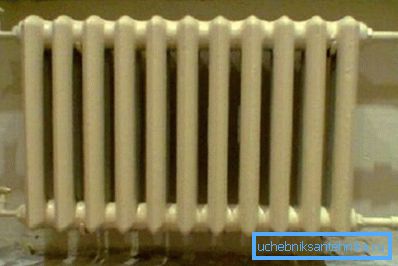
Where in the water air
The presence of air in the heating system is a rather frequent phenomenon, which is characteristic not only for apartment buildings, but also for private houses.
It appears for several reasons, independent of each other:
- The first is the repair work during the inter-heating period. They can be connected both with replacement and cleaning of pipelines or batteries.
- Errors made during installation of the heating system, consisting in non-compliance with the required slope or poor quality sealing joints. The price of such flaws is high.
- Lowering the pressure in the system due to a breakthrough or disruption in the operation of the pumping station.
- The air contained directly in the water in the form of microbubbles, when heated, is released and accumulates in places “convenient” for it.
Ways to get rid of air traffic jams
Currently, plumbing uses two main ways to remove air from the system. The first is to install an automatic air vent, the second is to install a manual regulating device, mounted, as a rule, on radiators.
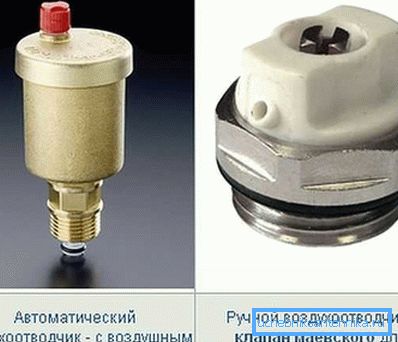
Appointment and installation of the automatic valve
Note! To think about the problem of airing the heating system, which in severe cases may require even its complete drainage, should be at the design stage and subsequent installation. It is necessary to ensure a constant slope of 3-5 ° in the direction of the coolant current from the lowest point of the pipeline to the highest one.
It will not be superfluous to foresee the installation of an expansion tank, which will allow the air to flow away unhindered. Additionally, at several points in the direction of flow of the coolant, places should be provided for fastening automatic air vent valves. Even systems with sufficient pressure are not insured against airing.
Automatic valves can be installed both vertically and horizontally. A prerequisite for their installation is the presence of a quality filter, as the devices are very demanding on the quality of the coolant.
Install the crane Mayevsky
Note! Not one of the official construction documents, SNiPs or GOSTs, does not use the name indicated in the title of the clause. The “radiator needle valve” is used. However, in specialized stores the seller will quickly respond to the name of the device.
It is a small modified nut, equipped with a mechanical valve, opening with a screwdriver or a special wrench.

In Soviet times, simple valve taps were often installed on radiators, which led to massive water withdrawal from the system.
The air vent for the radiator is mounted in one of the upper threaded holes of the heater. With any method of connecting the battery one of them, as a rule, is free.
The lower free hole is closed with a plug. It is inexpedient to mount Mayevsky's crane at the bottom, since it will be difficult to release air from the heating radiator - it accumulates in the upper points of the system.
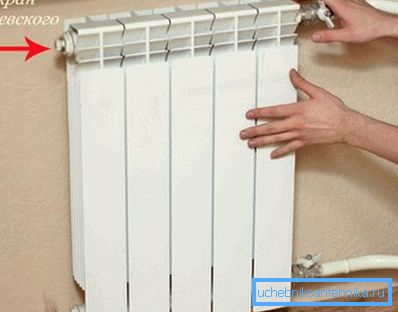
For the installation of the crane with your own hands, you will need an adjustable wrench or pipe wrench and winding. As the latter, you can use a special plumbing tape (fum tape) or natural flax paired with sealant.
The proposed instruction will help:
- Be sure to drain the system before working or shut off the radiator with stop valves.
- Check that the diameters in the hole and on the tap match.
- Wind a few turns of ribbon or flax hemp. It is better to grease flax with a small layer of pipe sealant.
- Screw the faucet in all the way so that the drain hole is turned from the wall and directed downwards at an angle of approximately 60 °.
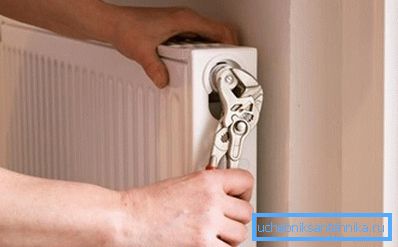
How to remove air from the radiator
Not all users know how to release air from a heating radiator correctly. This leads to many problems.
Given that the process is available even to the weaker sex, subject to a number of rules:
- Firstly, when working in a private house, immediately before releasing air from an aluminum radiator or other type of heater, turn off the booster pump.
- Arm yourself with a special wrench with a quad hole or a screwdriver (pre-examine your version of the crane Mayevsky).
- Be sure to prepare a metal container with a volume of 0.5 - 1 liter with a convenient handle.. It is better not to use glassware - in case of its fall, you will receive not only a puddle, but also an abundance of sharp fragments.
- Attach the container to the outlet of the valve and carefully unscrew the valve.
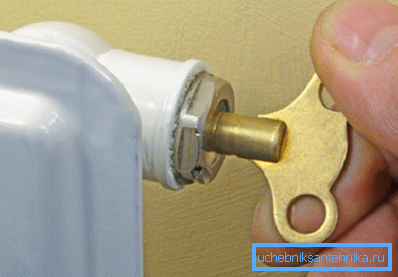
- The presence of a characteristic hiss indicates air outlet. A small amount of water can go along with it, take measures to protect the skin of your hands in case of burns.
- Do not unscrew the valve more than 1.5 - 2 turns. The lack of hissing and water leakage indicates the absence of an airlock in this particular radiator.
- After stopping the hiss, screw the valve back..
Using the above sequence of actions, you can easily restore the quality of the heating system of your apartment or private house without costly "help" of public utilities workers.
Instead of an afterword
The presence of heating does not always guarantee comfort and warmth in the rooms. Even with the quality of the system, no one is immune from the occurrence of such a common problem as airing. The above material will help to understand the causes of the phenomenon and eliminate it. More on this in the thematic video in this article.